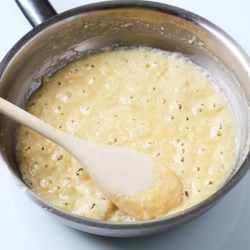Bechamel Sauce Recipe
Learn how to make this roux based bechamel sauce recipe and add it to lasagne or other recipes. Bechamel sauce is likely named after Louis Béchamiel, the marquis of Nointel, who worked for King Louis XIV more than 300 years ago. History is not clear if he was the actual inventor of the sauce or if he was simply being honored by having a sauce named after him. What is clear however is the importance of this sauce making technique in French cooking.
How to Make Bechamel Sauce

Making Roux
You can make the bechamel sauce recipe and its variants ahead of time and store them in the refrigerator overnight or freeze it. Having the sauce made ahead of time is particularly useful if you are going to incorporate it into another recipe.
The trick to making Bechamel is to add the milk slowly to the roux (melted butter and flour), fully incorporating the liquid before adding more. Some recipes recommend heating the milk before adding it to the roux, but I find this unnecessary, provided you add the milk slowly.
Once you have got the basic sauce mastered, take it for a ride. Try adding any of the following (but not all at once of course): garlic, onion, curry, paprika, mustard, or ketchup. You can also gently heat the milk with thyme or another herb to infuse the sauce with that flavor.
By adding cheese to bechamel you make sauce mornay (cheese sauce recipe), and by adding onions you make sauce soubise (onion sauce recipe).
Sauce béchamel
Preparation Time: 15 minutes
Makes 2 cups
This recipe is for two cups of sauce. Multiply or divide by the number of cups of sauce you need.
Ingredients
- 4 tablespoons butter
- 4 tablespoons flour
- 2 cups milk
- two pinches of nutmeg, salt, and pepper
Directions
- Place the butter in a medium sized saucepan on low medium heat and warm gently until it has melted. Measure in the flour and stir with a wooden spoon or spatula until combined. This mixture is called roux.
- Cook the roux for two minutes, stirring with your spoon. The roux should be bubbling and releasing steam.
- Now begin adding the milk, tablespoon by tablespoon. Completely incorporate each tablespoon of milk before you add more. After you've added about 1/4 of the milk, you can add more at a time. This is just a way of making sure that you don't get lumps in your sauce.
- Add all of the milk and cook, stirring occasionally. You can use a whisk to smooth the sauce, but a wooden spoon may be all you need.
- Heat the sauce just to below the boiling point. This should take approximately 10 minutes since the time you started adding the milk and the sauce should be quite thick.
- Remove the sauce from the heat and stir in the seasoning until completely combined.
- Allow the sauce to cool somewhat before using in another recipe or refrigerating/freezing for future use.
Variations
- Sauce Normande: Stir in 2 tablespoons heavy cream along with the seasonings.
- Sauce Aurore: Stir in 1 tablespoon concentrated tomato paste.
- Sauce Poulette: Immediately after removing from the heat, stir the sauce slowly into two egg yolks. This might be used as the basis for making a souffle.
- Sauce Moutarde: Proceed as for the sauce poulette, pouring the hot sauce over two egg yolks. Then stir in two teaspoons French style mustard, chopped parsley, and a little lemon juice.
Uses for Bechamel Sauce
- As an accompaniment to white meat (pork, chicken, turkey, veal or rabbit), fish, hard boiled eggs, or steamed vegetables. Note that this bechamel sauce recipe can taste a bit plain itself, so you might want to lively it up with one of the suggested additions if you will be serving it this way.
- As an ingredient in another recipe. For example, you can use bechamel in a lasagne, alternating layers of sauce, noodles, and perhaps a meat or vegetable layer. It is a key ingredient in the classic French comfort food: les endives au jambon - endives rolled in ham.
- As a starting point for many other French sauces. You will also find that some French recipes use the technique of adding flour to a melted butter base without calling it a bechamel - it is just part of the recipe, which really simplifies things and makes for quick dinners. Flamiche, a traditional dish from the north of France uses this technique: Bechamel Leek Tart Recipe.
So by learning how to make one simple French sauce, you greatly expand the range of French dishes you can easily master.
More French Sauce Recipes
Now that you have mastered this basic, versatile sauce, be sure to try another and keep building up your repertoire.
Return to French Sauce Recipes.
New! Comments
Have your say about what you just read! Leave me a comment in the box below.